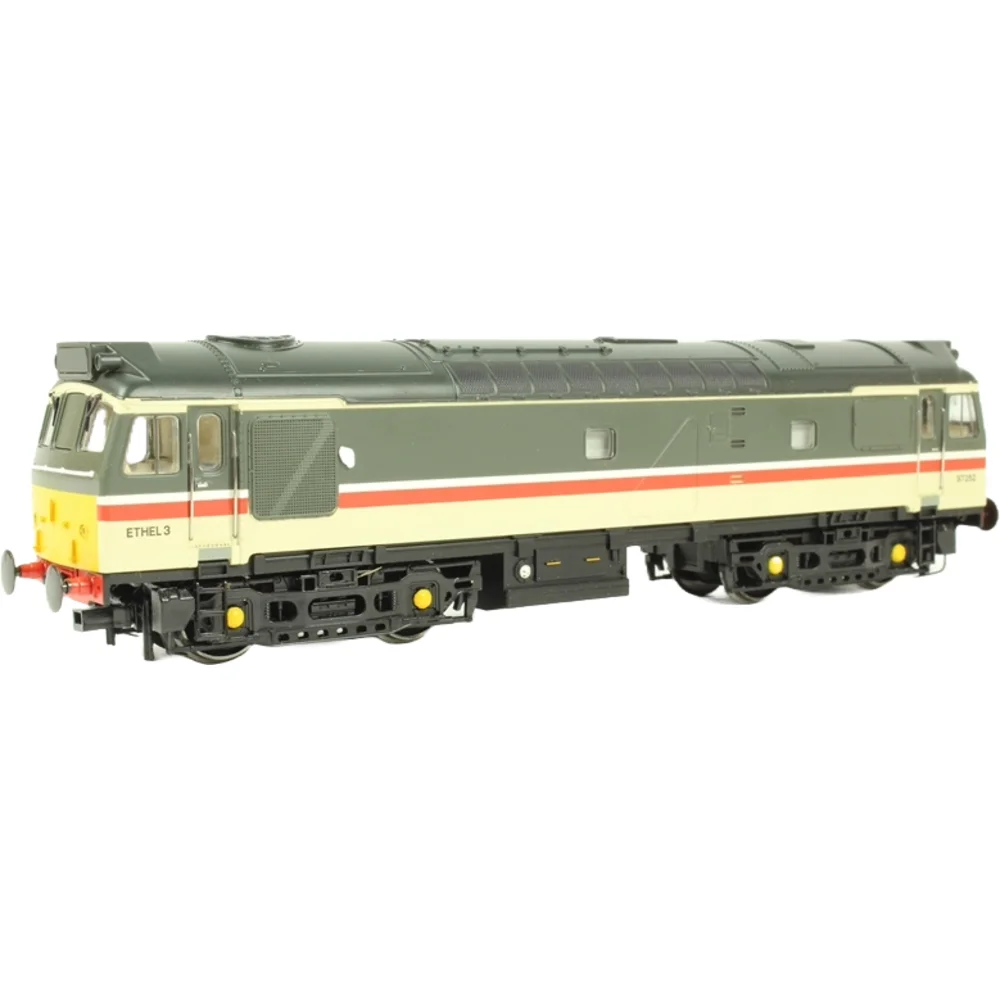Bachmann 32-400TF
British Rail Class 25 ADB97252 "Ethel 3" British Rail InterCity Executive
Tooling
Bachmann released an upgraded British Rail Class 25 model in 2003 for its OO gauge Branchline range. This tooling replaced the earlier 2001 version and introduced refinements in accuracy and detailing. The upgrade reflected growing expectations for higher fidelity in ready-to-run models, offering improved body shape, finer details, and enhanced mechanical performance while remaining accessible to modellers.
Tooling Features
- Scale: OO gauge (1:76)
- Construction: Injection-moulded plastic bodyshell with diecast metal chassis for strength and weight
- Detailing: Factory-fitted handrails, lamp irons, etched side grilles, bufferbeam detail packs, pipework, flush glazing, and painted cab interiors with crew figures
- Couplings: Tension-lock couplers in NEM pockets
- Minimum Radius: Second radius curves (approx. 438mm)
Mechanical & Electrical
- Drive: Centrally mounted can motor with twin flywheels driving all axles
- Pickups: All wheels for consistent current collection
- Weighting: Diecast chassis for improved traction
- Lighting: Directional headlights and tail lights, plus illuminated headcode panels
- Recommended running-in: Around one hour each direction at moderate speed
DCC Capability
DCC Ready with an 8-pin socket and provision for a 28mm round speaker for sound installation. This made digital conversion straightforward for modellers adopting DCC control.
Liveries Produced
- BR Green with late crest (1957–1972)
- BR Blue (1965–1990)
- InterCity Executive (1980s)
- Special editions including “Tamworth Castle” and ETHEL generator conversions
Reviews & Commentary
The 2003 upgrade was widely regarded as a significant improvement over the 2001 tooling. Reviewers praised the accurate body profile, etched grilles, and separately applied details. Performance was noted as smooth and powerful, aided by the twin-flywheel drive. Directional lighting and headcode illumination were welcomed features, though some enthusiasts commented that the model lacked factory sound options and more advanced lighting control compared to later standards. Forum discussions and early online reviews often described it as “a solid, dependable runner” and “a big step forward for Bachmann diesels.”
Interesting Notes
- Represented multiple sub-classes including 25/1, 25/2, and 25/3 variants
- Body removal was simple, aiding decoder and speaker installation
- Set the stage for further refinements in 2006 with 21-pin DCC sockets and additional detail upgrades
Class & Prototype
- Class: British Rail Class 25
- Traction: Diesel
- Transmission: Electric
- Built: 1961-1967
- Total Built: 327
No prototype found.
Operator & Livery
- Operator: British Rail InterCity
- Livery: Executive
British Rail InterCity was the premium express passenger brand that operated from 1966 to 1997, transforming long-distance rail travel across Britain. Initially launched as a marketing brand for high-speed services, InterCity became an autonomous business sector in 1982 under the sectorisation programme, operating profitable express services from London to Scotland, Wales, the West Country, and extensive cross-country routes.
The brand pioneered revolutionary rolling stock including the iconic InterCity 125 HST (High Speed Train) from 1976, which achieved 125mph operations on existing infrastructure, and the electric InterCity 225 sets from 1989, capable of 140mph but limited to 125mph in service. InterCity also developed the ground-breaking Advanced Passenger Train (APT) with tilting technology that influenced modern high-speed trains worldwide.
Distinguished by its evolving livery schemes - from Rail Blue and Grey through the sophisticated Executive livery with dark grey upper bodies and red stripes - InterCity became synonymous with quality, speed, and reliability. All day services featured buffet cars and the majority operated at 100mph or above, making British Rail one of the world's most intensive high-speed operators.
The brand was divided among multiple operators during railway privatisation in the 1990s, but its technical innovations, operational excellence, and commercial principles continue influencing modern rail services. InterCity remains hugely popular with railway modellers, with extensive ranges of locomotives and coaching stock available in all major scales from manufacturers like Hornby, Bachmann, and Heljan.
